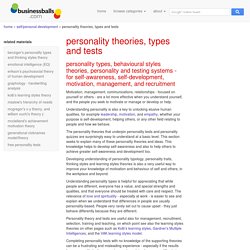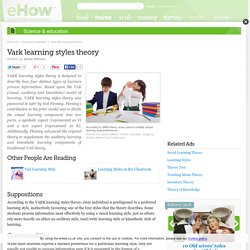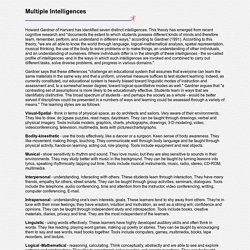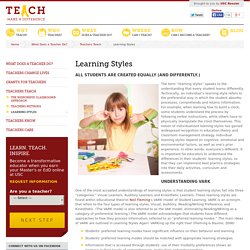

Vark. Can neuroscientists dispel the myth that children have different learning styles? Over the past few years, there seems to have been a insidious pandemic of nonsense neuroscientific claims creeping into the education system.

In 2013, the Wellcome Trust commissioned a series of surveys of parents and teachers, asking about various types of educational tools or teaching methods, and the extent to which they believe they have a basis in neuroscience. Worryingly, 76% of teachers responded that they used learning styles in their teaching, and a further 19% responded that they either use, or intend to use, left brain/right brain distinctions to help inform learning methods. Both of these approaches have been thoroughly debunked, and have no place in either neuroscience or education. In October last year, I reported on another study that showed that in the intervening time, things hadn’t really improved – 91% of UK teachers in that survey believed that there were differences in the way that students think and learn, depending on which hemisphere of the brain is ‘dominant’. Personality styles, types, theories and psychometrics models, personality tests and quizzes theory.
Personality models on this page The Four Temperaments/Four Humours Carl Jung's Psychological Types Myers Briggs® personality types theory (MBTI® model) Keirsey's personality types theory (Temperament Sorter model) Hans Eysenck's personality types theory Katherine Benziger's Brain Type theory William Moulton Marston's DISC personality theory (Inscape, Thomas Int., etc) Belbin Team Roles and personality types theory The 'Big Five' Factors personality model FIRO-B® Personality Assessment model The Birkman Method® Lumina Spark Morphopsychology.

The Learning Styles Questionnaire. Learning style preferences determine the things people learn and the ease with which they learn them.

Learning Styles questionnaire. Vark learning styles theory. VARK learning styles theory is designed to describe how four distinct types of learners process information.

Based upon the VAK (visual, auditory and kinesthetic) model of learning, VARK learning styles theory was pioneered in 1987 by Neil Fleming. Fleming's contribution to the prior model was to divide the visual learning component into two parts, a symbolic aspect (represented as V) and a text aspect (represented as R). The VARK Questionnaire. Gardner's Multiple Intelligences. Howard Gardner of Harvard has identified seven distinct intelligences.

This theory has emerged from recent cognitive research and "documents the extent to which students possess different kinds of minds and therefore learn, remember, perform, and understand in different ways," according to Gardner (1991). According to this theory, "we are all able to know the world through language, logical-mathematical analysis, spatial representation, musical thinking, the use of the body to solve problems or to make things, an understanding of other individuals, and an understanding of ourselves. Where individuals differ is in the strength of these intelligences - the so-called profile of intelligences -and in the ways in which such intelligences are invoked and combined to carry out different tasks, solve diverse problems, and progress in various domains. " Birmingham Grid for Learning - Multiple Intelligences (Secondary) How To Be An eTutor. Learning Style Theories.
All Students are Created Equally (and Differently.)

The term “learning styles” speaks to the understanding that every student learns differently. Technically, an individual’s learning style refers to the preferential way in which the student absorbs, processes, comprehends and retains information. For example, when learning how to build a clock, some students understand the process by following verbal instructions, while others have to physically manipulate the clock themselves. 3.2.6 Identifying Learner Needs. Multiple intelligences - howard gardners multiple intelligences theory - visual auditory kinesthetic learnings styles VAK model. Free VAK visual auditory kinesthetic learning styles test questionnaire. Vak - visual, auditory, kinesthetic - learning styles model and free self-test The VAK learning styles model and related VAK learning styles tests offer a relatively simple methodology.

Therefore it is important to remember that these concepts and tools are aids to understanding overall personality, preferences and strengths - which is always a mixture in each individual person. As with any methodology or tool, use VAK and other learning styles ideas with care and interpretation according to the needs of the situation. They are guide as to the mixture of preferences, strengths and learning styles in an individual, not a basis for deciding on one exclusive preference or approach to the exclusion of everything else.
On this point, the Kolb Learning Styles page offers additional notes on the use of Learning Styles in young people's education.